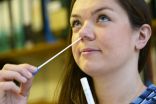When it comes to teen alcohol use, close friends have more influence than peers
2014-11-19
(Press-News.org) A recent study by an Indiana University researcher has found that adolescents' alcohol use is influenced by their close friends' use, regardless of how much alcohol they think their general peers consume.
Jonathon Beckmeyer, assistant professor in the Department of Applied Health Science at the IU School of Public Health-Bloomington and author of the study, said his research generally focuses on the onset of teen alcohol use and how their social relationships shape those experiences.
"We've known for a long time that friends and peers have an influence on individual alcohol use, but there are no common studies that distinguished between the broader peer group and the friend group's influence on those decisions," Beckmeyer said.
Data used for the study were taken from the National Institute of Child Health and Human Development's Study of Early Child Care and Youth Development. Each participant was 15 years old and was asked a series of questions related to how many teens their age and how many of their friends they thought consumed alcohol, and whether they had consumed alcohol themselves in the past year.
The study demonstrated that the participants' perceptions of how many teens in their direct friend group had consumed alcohol held more weight than the perceptions of how many of their peers overall were consuming. In other words, even if a teen perceived that many teens in general consumed alcohol, they were less likely to have experimented with it themselves if they did not think their friends drank alcohol.
"We're spending our time changing perceptions of the broader peer group, but really what might be the more key determinant of teen alcohol use is what's going on in their own friend group," Beckmeyer said. "Really working to encourage teens to make friendships with non-alcohol-using friends could be one of the more effective things parents can do to help."
Beckmeyer presented his study, "Comparing perceptions of how many peers and friends use alcohol: Associations with middle adolescents' own alcohol use" on Nov. 19 at the American Public Health Association's Annual Meeting and Exposition in New Orleans, Louisiana.
INFORMATION:
Beckmeyer can be reached at jbeckmey@indiana.edu. For additional assistance, contact Milana Katic at mkatic@iu.edu.
[Attachments] See images for this press release:

ELSE PRESS RELEASES FROM THIS DATE:
2014-11-19
SAN FRANCISCO, Nov. 19, 2014 -- Hox genes are master body-building genes that specify where an animal's head, tail and everything in between should go. There's even a special Hox gene program that directs the development of limbs and fins, including specific modifications such as the thumb in mice and humans. Now, San Francisco State University researchers show that this fin- and limb-building genetic program is also utilized during the development of other vertebrate features.
The discovery means this ancient genetic program is employed in a variety of features beyond ...
2014-11-19
A new study, published online in Brain: A Journal of Neurology today, followed 43,368 individuals in Sweden for an average of 12.6 years to examine the impact of physical activity on Parkinson's disease risk. It was found that "a medium amount" of physical activity lowers the risk of Parkinson's disease.
Karin Wirdefeldt of the Karolinska Institutet in Stockholm and her colleagues used the Swedish National March Cohort to analyse comprehensive information on physical activity of all kinds. They assessed household and commuting activity, occupational activity, leisure ...
2014-11-19
A new study led by researchers at King's College London in collaboration with the US Consortium of Food Allergy Research and the University of Dundee has found a strong link between environmental exposure to peanut protein during infancy (measured in household dust) and an allergic response to peanuts in children who have eczema early in life.
Around two per cent of school children in the UK and the US are allergic to peanuts. Severe eczema in early infancy has been linked to food allergies, particularly peanut allergy.
The study, published in the Journal of Allergy ...
2014-11-19
New research on a number of Canadian lakes show that historical acid deposits as a result of industry have greatly reduced calcium levels in the water - dramatically impacting populations of calcium-rich plankton such as Daphnia water fleas that dominate these ecosystems.
Falling calcium levels mean Daphnia cannot get the nutrients they need to survive and reproduce, and are consequently consuming less food and becoming more susceptible to predators, leaving more algae for other organisms to feed on.
This has left a small jelly-clad organism called Holopedium to take ...
2014-11-19
People with airway diseases, including asthma and chronic obstructive pulmonary disease (COPD), have a higher incidence of inflammatory bowel disease, such as Crohn's disease and ulcerative colitis, according to the findings of a new study.
The research, which is published online today (19 November 2014) in the European Respiratory Journal, is the first population-based study to examine the association between airway diseases and the incidence of bowel disease. The news comes on World COPD Day, which aims to improve awareness and care of COPD.
The results showed that ...
2014-11-19
Researchers from the University of East Anglia (UEA) are a step closer to enhancing the generation of clean energy from bacteria.
A report published today shows how electrons hop across otherwise electrically insulating areas of bacterial proteins, and that the rate of electrical transfer is dependent on the orientation and proximity of electrically conductive 'stepping stones'.
It is hoped that this natural process can be used to improve 'bio batteries' which could produce energy for portable technology such as mobile phones, tablets and laptops - powered by human ...
2014-11-19
People taking part in this year's Flusurvey, the UK's biggest crowd-sourced study of influenza will for the first time be offered a swab to confirm if their symptoms are caused by a flu virus or not as part of a new collaboration with i-sense. Data from social media and internet searches will also be combined with Flusurvey, allowing flu trends to be monitored across the UK more accurately and earlier than ever before.
Flusurvey scientists at the London School of Hygiene & Tropical Medicine will analyse weekly information relating to symptoms, provided in an online questionnaire ...
2014-11-19
David King, clinical lecturer in paediatrics at the University of Sheffield, says medical professionals and consumers need to be aware that such devices "have no proved use in safeguarding infants or detecting health problems, and they certainly have no role in preventing [sudden infant death syndrome] SIDS."
Wearable devices for infants are a growing industry worldwide. Devices that attach to a newborn baby to monitor its vital signs are marketed by several US companies at a cost of around $200 to $300 to give parents "peace of mind" about their baby's health.
One ...
2014-11-19
The authors say their findings are applicable to law enforcement work outside the US and support the view that stressful work related activities can "trigger" sudden cardiac death.
Law enforcement is a dangerous occupation. In 2011-2012, the fatality rate among US patrol officers was 15-16 per 100,000 full time workers - about 3-5 times the national average for private sector employees.
Some evidence suggests that cardiovascular disease is higher among police officers than the general population, but data about the impact of specific on duty activities ...
2014-11-19
Observational studies have suggested that lower levels of vitamin D are associated with increased mortality, but whether low vitamin D concentrations are a cause of increased mortality or simply a consequence of poor health is thus unclear.
This is an important question, say the authors, as millions of people worldwide are regularly taking vitamin D supplements, presumably with the aim of preventing diseases and hopefully living longer.
Genetic variants have been reliably associated with circulating concentrations of vitamin D, a marker of vitamin D status. So a research ...
LAST 30 PRESS RELEASES:
[Press-News.org] When it comes to teen alcohol use, close friends have more influence than peers



